These notes are to introduce the main results of the work on modeling global population growth with special reference to the long term priorities and the challenges set by the demographic transition in view of Rio+10. After the demographic revolution the global population is to stabilize as the world is moving into a new age structure, when the number of older people is to outnumber the younger ones. The most important changes are due to the development of an information dominated society, where of central importance become culture, science and education. The education industry at the later stage of the demographic revolution may become the most significant sector of the knowledge society, a fact not usually recognized. It are these issues of the demographic and socioeconomic development that should be of our main concern in assessing the future of the world, as it is entering the 21st century passing through the rapid and greatest crisis, since the beginning of the human story.
1. IntrThe sciences do not try to explain, they hardly even try to interpret, they
mainly make models. By a model is meant a mathematical construct which
… describes observed phenomena. The justification of such a mathematical
construct is solely and precisely that it is expected to work.
John von Neumann
Introduction
These notes are to introduce the main results of the work on modeling global population growth with special reference to the long term priorities and the challenges set by the demographic transition in view of Rio+10. After the demographic revolution the global population is to stabilize as the world is moving into a new age structure, when the number of older people is to outnumber the younger ones. The most important changes are due to the development of an information dominated society, where of central importance become culture, science and education. The education industry at the later stage of the demographic revolution may become the most significant sector of the knowledge society, a fact not usually recognized. It are these issues of the demographic and socioeconomic development that should be of our main concern in assessing the future of the world, as it is entering the 21st century passing through the rapid and greatest crisis, since the beginning of the human story .
|
2. The changes in population of the world
|
In this study, when discussing the state of the world in an attempt to discern the trends of development demographic factors are mainly taken into account. By giving such prominence to the dynamics of human numbers, the singular importance of this main characteristic of growth is emphasized. It is this parameter that we have used all through the discussion of the growth of humankind in developing a non-contradictory and consistent quantitative systemic theory to describe the gross features of the past and present. But only the concepts of anthropology and history, economics and sociology can add a further dimension to these numbers, provide a socially relevant content, where the human side of growth and development, of wealth and misery, enter the analysis. For in these terms we customarily seek to find an explanation of what is happening, expressing them as economic power and political will in ‘explaining’ our past and facing the present predicament. But this can only be done, if an understanding is reached of the grand design of history, reconciling the local and temporal events with the dictate of the demographic imperative.
|
Table 1. Population dynamics for the world, Asia and Europe
|
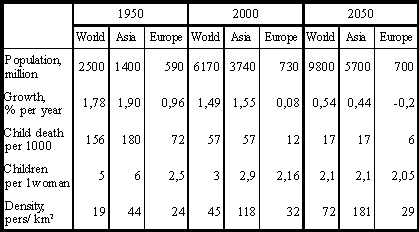 |
|
Table 2. Structure and dynamics of the population of the world. (UN data)
|
 |
The demographic indicators are a message for contemplation and action. The appropriate demographic policies should be defined and pursued as part of national, social and economic plans for development. Although at present most governments do have such programs, but on a global scale the influence of these policies do not have a major effect, for the inherent power of the demographic process overrules these efforts at a time of rapid change. Of special concern is the flux of migrants, so any studies of future developments should take into account the impact of immigration.
|
3. The open model and the population imperative
|
The success of modeling global population growth and its general agreement with anthropological and historic data both in population numbers and with the cycles observed in our past, shows how the human system has been developing over an immense period of time, right from its very beginning. The model is based on a phenomenological description of the growth of an interacting and open system — the global population. The global population as a system is both isolated and open, meaning that it can draw on the resources of the environment, of the outside world. No constraints and limits appear in the theory, as far as external resources are concerned: in economic theory these are termed open-access resources. As the whole population of the world is treated as a system, a single object, the details and events are all averaged and mixed in the totality of the system. In other words, the whole approach is essentially statistical and cannot be expected to take account of details, however significant they may seem. But these partial events should be seen on the backdrop of the total picture.
According to the model, growth is determined not by resources, but by the intrinsic process of development, and is driven by the collective global interaction:
|
|
= | (1) |
where![]() = 62 000 is the main parameter, determining the rate of growth for a collective binary interaction, and time t = T/t is expressed in units of t = 45 years. Equation (1) means that the rate of growth
= 62 000 is the main parameter, determining the rate of growth for a collective binary interaction, and time t = T/t is expressed in units of t = 45 years. Equation (1) means that the rate of growth![]() is equated to the development
is equated to the development![]() . The expression for development states that growth depends on the total number of people in the world N. It is a function — the square — of the number of people, as an expression of the network complexity of the global population. This essentially nonlinear relationship leads to the formula describing asymptotic blow up:
. The expression for development states that growth depends on the total number of people in the world N. It is a function — the square — of the number of people, as an expression of the network complexity of the global population. This essentially nonlinear relationship leads to the formula describing asymptotic blow up:
|
|
= | billion. | (2) |
This formula applies to the population of the world N and cannot be used to describe any subsystem or country. In the next approximation a cut-off with a characteristic time of t years is introduced, which describes the demographic transition and determines the asymptotic limit of the population![]() billion. This is twice as large as the population of the world at the peak of the global population transition of 6 billion in year 2000. These numbers agree with estimates made by demographers for the next 200 years. On the other hand, an estimate of the beginning of the human story
billion. This is twice as large as the population of the world at the peak of the global population transition of 6 billion in year 2000. These numbers agree with estimates made by demographers for the next 200 years. On the other hand, an estimate of the beginning of the human story![]() million years ago can be made and of the arrival of the tool making Homo habilis 1.6 million years ago.In developing the model the main point is to limit the number of variables to a single one — the global population N. The quadratic interaction is the main growth factor and depends only on the total number of people, with no extra parameters appearing in the ‘short’ equation (1). Limiting the number of variables to N — to the global population is essential. In this way one can get away with the ‘curse of complexity’, for Herbert Simon has noted that «forty years of experience in modeling complex systems on computers, which every year have grown larger and faster, have taught us that brute force does not carry us along a royal road to understanding such systems┘ modeling, then calls for some basic principles to manage this complexity». This was recently discussed by Mike Mesarovic, who indicated the importance of the DRM principle — that of building dominant relations models and choosing the appropriate dynamic variables. This theory is based on the principle of the dominant variable, worked out by Haken for the asymptotic behavior of complex systems in synergetics and expressed by the demographic imperative in global population dynamics.
million years ago can be made and of the arrival of the tool making Homo habilis 1.6 million years ago.In developing the model the main point is to limit the number of variables to a single one — the global population N. The quadratic interaction is the main growth factor and depends only on the total number of people, with no extra parameters appearing in the ‘short’ equation (1). Limiting the number of variables to N — to the global population is essential. In this way one can get away with the ‘curse of complexity’, for Herbert Simon has noted that «forty years of experience in modeling complex systems on computers, which every year have grown larger and faster, have taught us that brute force does not carry us along a royal road to understanding such systems┘ modeling, then calls for some basic principles to manage this complexity». This was recently discussed by Mike Mesarovic, who indicated the importance of the DRM principle — that of building dominant relations models and choosing the appropriate dynamic variables. This theory is based on the principle of the dominant variable, worked out by Haken for the asymptotic behavior of complex systems in synergetics and expressed by the demographic imperative in global population dynamics.
In fact, we shall see that all through history humankind globally really had enough resources, whether space, food or energy. If at any stage locally resources became limited, then people moved to other places, spreading all over the globe, traditionally settling near great rivers. Famine certainly hit human populations all through history and locally a lack of food could lead to great loss of life. But on a larger scale mankind always carried on and all through its history has shown remarkable resilience and overall stability of growth, up to the very moment of the population transition.
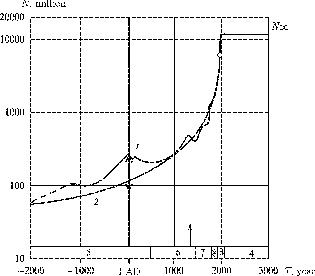 |
| Figure 1. World population from 2000 BC to 3000 AD. Limit billions 1 — data of Biraben , 2 — blow up growth, 3 — demographic transition, 4 — future stabilized population, 5 — Ancient world, 6 — Middle Ages, 7 — Modernity, 8 — Recent history, ╜ — the Plague, o — 1995. As the demographic transition is approached, the time of history and development is compressed |
On a semi-logarithmic plot it is seen that growth follows a hyperbolic curve, going off to infinity as it approaches year 2000, when an abrupt change in the pattern of growth takes place. In less than a hundred years the population of the world will level off, mainly due to growth of the developing world, and stabilize at 10 — 12 billion. In the framework of the model, the driving force leading to growth is the global cooperative interaction, and the only resource that is limiting growth and development is really a generalized information exchange. The explanation suggested is that the quadratic law may be interpreted in terms of the transfer of information, and communication as the basis of a statistical collective interaction. The distribution and transfer of information from one generation to the next — knowledge and technology, customs and crafts, art and religion, and, finally, ideas and concepts of science — this is peculiar to humans and human society, and what makes us essentially different from all animals. For at present human beings outnumber by five orders of magnitude — a 100 000 times — any other animal of comparable size and position in the food chain. It may be surmised that information transfer moderates and is essential to the growth and development of humankind, for the process of information propagation and exchange is cooperative and multiplicative. In this process education and training in all forms and varieties, including games, is a major part of human development. Consider the very first steps of a human being that are quite different from those of all other animals: the long childhood, first learning to speak and mastering language, being brought up, taught and educated in the making of a man, to use an old expression, as a member of society. This now takes 20 to 30 years and is essential for every human being. Thus information is transmitted vertically between generations, establishing powerful links both with the past and contemporaries, links deeply entrenched in
|
Table 3. Growth and development of mankind, shown on a logarithmic scale
|
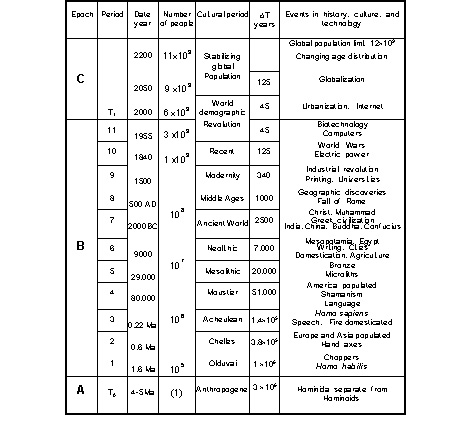 |
the personality of each member of society. Information is also transferred horizontally — in the space of informational interaction. The result of modeling are all shown in Table 3, summing up both the outcome of calculations and observations of historians, anthropologists and demographers. Estimates of the periods of the past are given that agree well with the dates identified by historians and anthropologists, although the global populations in these bygone epochs are known only within an order of magnitude. An important concept is the compression of time of social development. Long recognized by historians, the transformation of time of systemic development is explained in terms of the kinematics of self-similar hyperbolic growth, culminating at the global population explosion, and now terminated by the demographic transition.
Developing this reasoning further has led to a phenomenological theory, which describes the whole human story, right from its very beginning 4-5 million years ago. A decisive step was to identify the global population not as a mere sum of all countries, but as an entity, as a dynamic system. This and the recognition of the collective nature of the interaction, driving the growth of the global population, were essential. It are these connections, which become the main factor in uniting people, in organizing their cooperation, synchronizing development and setting up common patterns of action. In this context information should really be seen as a generalization, as the factor statistically summing up all contributions to growth of an economic, cultural or biological nature in the human story.
These ideas of a summary interaction are drawn from physics and modern developments in nonlinear studies of complex systems. They are not generally known to social scientists, economists and global modelers that now have to accommodate to this exercise in interdisciplinary research. On the other hand, it may be conjectured that this agent, affecting the state of each person an society, is associated with human consciousness, be it individual or social. The action of the global interaction is similar to lamarkian evolution, when acquired features are inherited in the population system.
|
4. The demographic transition
|
It is now well established that all countries pass through a maximum growth rate at the demographic transition, then followed by stabilization of the population. This has been observed for all developed countries and is now being seen in countries of the developing world. The global demographic transition is shown on Fig. 2. Most demographers, following the tradition of their science, usually consider the demographic transition in various countries, classifying in detail the historic, social and economic conditions, as the pattern of growth and procreation changes. It is obvious that the global character of the transition is not taken into account, for then it is difficult to identify the causes of changes.
During the transition death and birth rates rapidly change, beginning with an initial decrease in the death rate. The consequent fall in the birth rate starts later, and is accompanied by economic development, an increase in the standard of life and the development of health services, initially leading to a longer life expectancy. Due to the interaction of these two factors, the growth rate passes through its maximum value. Later, as the result of the decrease both in birth and death rates, that tend to the same limit after the transition, the resulting growth rate gradually approaches zero, as the population is to stabilize. For any specific country migration may modify this idealized description, but globally emigration does not enter into the growth rate as far as the population is limited to our planet. This sequence of events shows that the whole change is rapid and at no point is the population in any state of relative equilibrium. In fact, we are dealing with a non-equilibrium transition, centered on year 2000, a veritable shock that could hardly happen faster. As a result of the transition the population ceases to grow and a marked change in the age distribution of the population develops. This is the last in the sequence of events and a very significant transformation to happen in a society. See Fig.4. Only in terms of a systemic approach and by treating the whole phenomenon as a phase transition of the type well known in physics, is it really possible to understand the complex nature of what is going on. As an essentially nonlinear and rapid transformation the transition involves many processes, all happening at the same time and interdependently coupled in the population explosion. The synchronism of regional changes of the growth of the world population system shows that we are definitely dealing with a collective global phenomenon and of all manifestations of globalization this is the most significant one, a fact not usually recognized.
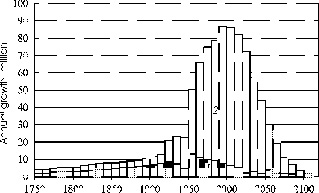 |
| Figure 2. World demographic transition 1750 — 2100. Annual growth averaged over a decade. 1 — developed countries, 2 — developing countries. The global transition is remarkably short with a half-width of t = 45 years, the characteristic time of the system. |
This also makes it all the more to difficult to identify the factors determining the passage through the transition, although the educational and medical aspects are probably the most important social and demographic ones in the growth and economic development of each country. These processes are accompanied by urbanization, with vast movements of rural population to towns. As the population of the world acts as a truly global community, undergoing a common transformation, the transition in the developed and developing countries are happening practically at the same time, separated by a mere 50 years, showing that in a fundamental way these countries are not so different as it is usually assumed, a significant point worth keeping in mind.
The global population transition takes 90 years, and during this time, that is only 1/50 000 of all our history, a fundamental change in the mode of the growth of humankind is to happen. To imagine how abrupt the transition really is, it makes sense to place its beginning on Fig. 2: a point corresponding to 5 million years ago is well off the limits of the page, somewhere around one kilometer to the left! All through that time human numbers grew in a self-similar pattern, following a hyperbolic path of growth described by (2). A different image of the transition is seen, if we refer to the number of people — some 10 billion — who are to live through the population transition. This is 1/10th of the hundred billion people who ever lived, and is the chance for a human being to be caught into this period of rapid change.
As the global demographic transition develops, a marked sharpening of the transition in developing countries takes place: the later the transition, the shorter its duration. The narrowing is due to the nonlinear interaction between countries, constituting the global population system. It also takes place in the largest countries — China and India. Sub-global in population size and bringing together regions at very different stages of development, these countries demonstrate the same synchronizing interaction in the collective way they experience the transition. The narrowing is typical for interactive nonlinear dynamic systems and on its own indicates the existence of the global interaction, introduced to explain global population growth, an interaction involving the exchange and propagation of information throughout the global system. In the case of the population transition one sees how this interaction affects the demographic development of billions of people, in a fundamental and profound way changing the procreation of the largest communities in the world at very different stages of development, now passing through a decisive transformation.
|
5. The environment
|
In discussing the long term energy future of our planetary civilization much is said about the impact of energy and industry on the global environment. For some the environment is becoming of even greater significance than the population, to the extent that an environmental imperative is pronounced, although all through human history the population has dominated at the cost of great degradation of the environment. For example, the environment of most of Europe is no longer natural. Even greater is the impact of civilization in China with its very high density of population, living along its great rivers in an artificial, but stable and sustainable environment over the ages. These conditions of life are far from those practiced in Europe, but they have been sustained in one of the oldest, if not the oldest continuously recorded civilization.
If one assumes a consistent systemic point of view, in that case the growth of human numbers will be determined by global population dynamics, driven by the priorities of the population imperative. This does not mean that nothing can or should be done. Rather the opposite, but our behavior at large is an expression of systemic development that statistically adds up into global growth. Following a systems approach in an integrated treatment of global population growth these issues are taken into account. As far as all previous history is described by the model, the only thing left is the extent to which this treatment can be projected into the future and when, if ever, it is to break down. In other words, will the demographic imperative, expressed by the model, stand the test of time in the future, and if not, where are its limits?
At first, it may seem that nothing has to be done as the global population system will look after itself, including the development of our own attitudes towards these issues. On the other hand, what is the extent to which humankind can take over guidance, if not the responsibility for its own future? This has already been mentioned and much depends on the limits of our reasoning. What may happen, is that according to the conjectured interpretation of the nature of the global interaction as an expression of our consciousness, of the social consciousness of humankind for that matter, including our capacity to develop new technologies, could change the limits of nature.
At any rate, in the foreseeable future in a world with a stabilized and stable future population of some 10 to 12 billion there will be enough resources to sustainably support the global population system within the main assumptions of the phenomenological theory. Global population dynamics has a drive and logic of its own, and only by reaching an in depth and fundamental understanding of these complex interdisciplinary problems can we expect these universal issues to be faced and responsibly resolved by sensible demographic and economic policy. The extent of the difficulties of controlling demographic systems, demographic data has repeatedly shown that these problems are not only complex, but any direct intervention is not really productive. To exercise an effective global demographic policy, apart from a general medical and educational program, practiced by a number of international organizations, and taking into account that major changes are to happen in the next decades, the global transition will be determined more by nature rather than by policy.
|
6. Do resources limit growth?
|
The lack of any immediate effect of resources, other than generalized information, is a point that needs to be discussed, for it contradicts conventional Malthusian wisdom, epitomized in the first Report to the Club of Rome. At present the main limit is that of time, for the acceleration of growth cannot be sustained any longer. If the global population system had pursued its self-similar pattern of growth, as is did all through the ages, then our numbers would be 8 billion and not 6 billion, as it is now. On the other hand, humankind in the future may still reach a stage of development when resources could limit our growth, although this stage is beyond the limits of modeling.
The distribution of the population worldwide is very far from uniform. If there were a general lack of resources, then the first reaction would be a much more uniform distribution of population than the one seen. If in the past there have been massive movements of people, at present migrations throughout the world affect less than 0.1% of the global population in a year, a flux smaller by an order of magnitude than the annual increase of the population of the world. This can indicate that globally there are enough resources, and any local lack may be ascribed to conditions of war, disruption of society and famine, often caused by a local blow-up of population, as a result of the population transition. The disparities in population distribution and resources is what matters, and it is here that most current economic, political and military problems appear. The main reason for migration is economic inequity, often amplified by demographic and ethnic factors and expressed by political pressures, which on many occasions may ultimately be resolved by military means. That is why the population explosion of the developing countries at present is a greater threat to global security than the perceived world wide lack of resources
In matters of food resources it is instructive to compare India and Argentina. The area of Argentina is but 30% less than that of the subcontinent, but the population of India, now greater than one billion, a country with an ancient civilization, is 30 times greater than that of Argentina, where modern development began 200 years ago. But, as it has been stated by experts, Argentina, with its great agricultural resources, in principle could feed the whole world. The self-similar pattern of the development of humankind definitely shows that there are enough resources globally and they do not limit population growth and be the malthusian reason for the demographic transition.
|
7. Distribution of wealth in the global system
|
Distribution of wealth, like the ranking of towns is usually analyzed for each country and is aptly described by a Pareto distribution — a generalized hyperbolic power law. These fractal power laws are typical for systems far from equilibrium and are established by the recursive pattern of the processes going on in an evolving and growing dynamic system, showing the degree of chaos in economics. In practical terms it is best to indicate the ratio of the richest to the poorest parts of society, as an indicator of the economic disparities in a society. See Table 4. These numbers show that in countries that have advanced far in their development after the demographic transition, like Germany and Japan, per capita annual income is both high and the
|
Table 4. Distribution of wealth in the world (1995 UNESCO data)
|
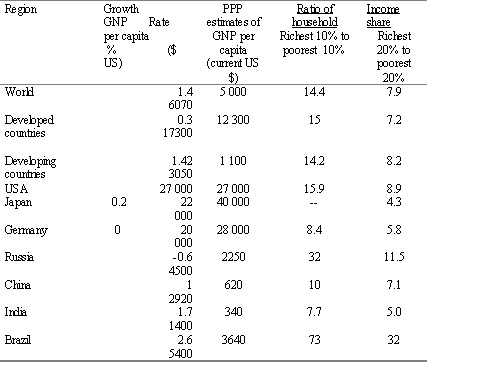 |
distribution is more egalitarian. In the case of a rapidly developing county, like Brazil, the distribution is very far from being egalitarian. In the case of Russia the disparities are undoubtedly due to the economic and moral crisis, the social injustice of the uncontrolled market, political chaos and the miscarriage of democracy after the collapse of the Soviet Union. Although the disparities and injustices of the world are beyond the resolution of the model, as these differences are all absorbed in the gross statistical approach of the global model that deals with the demographics as the sole expression of growth.
On one hand the remarkable rate of the growth and development of China and India unequivocally shows the validity of this approach for the largest countries. On the other hand, the high growth rate of the transition in African countries, accompanied by wars and famines, mass movements of tribes and people, only show the universal character of the demographic transition in different economic, social and geographic environments. Now these countries are all part of the global system and are all caught into the transition, although they are much less socially and industrially developed than some other countries of the developing world. This mismatch of development and of the demographic transition is beyond the agenda of this report, but these factors should be taken into account in any detailed study of these issues. But what we see is that the power of the demographic system’s dynamics is greater than the local regional or temporal differences observed, leading to the synchronous development of the whole world, coupled by the global interaction. The demographic transition, that is really a global demographic revolution, is changing the behavior of countries in the most important function of any society — in the way people multiply their numbers.
|
8. Economic growth and development after the demographic revolution
|
The meaning of the model is that it equates the rate of growth to the development of the population system seen as a function of the global population — the square of the total number of people — the production function of the global economy. This is an essentially nonlinear function and is not what would be expected in an economic system that is usually assumed to be in the first approximation linear and additive in a relatively slow process of growth of industry and agriculture. The non linearity is ascribed to the part taken up by the generalized informational interaction, operating in the global population system. This interaction is multiplicative and irreversible, and is the dominant feature of the system, determining or rather moderating its growth. In other words, the contribution of the quadratic term is decisive in determining growth all through our history and expresses the contribution of the informational component to the global production factor. This can be seen as the domination of the ‘software’ of global development, the component that is associated with culture, science and all those factors like cooperation, communication, consciousness and memory in interpreting the metaeconomic nature of the growth of mankind. This indicates the primacy of the collective factors in society that we owe to our highly developed brain, the main and peculiar characteristic of Homo sapiens.
In the post transitional society a factor of primary importance will be education, taking up more time and effort than at any other period in the history of humankind, for at present in developed countries lifelong education has become a reality. But neo-classical economic theory does not really take into account the ‘software’ component in constructing models of development, being mainly occupied with an understanding of how the ‘hardware’, industry and agriculture in the first place, works and generates wealth. But in the case of humankind it seems that the fundamental reason for development and growth is this software component. Moreover, in some developments of modern economic theory, it is now acknowledged that in the non- equilibrium nature of growth software has to be taken into account. One of the problems is how to deal with intellectual property, how this property is generated and how it is distributed and multiplied. The last point is the most difficult one, for information cannot be treated as an ordinary economic entity, a commodity, and exchanged as any other product. For its multiplicative and irreversible nature when propagated, leads to the difficulties with intellectual property in a market economy. What the model suggests is that information is not a minor component of macroeconomics, but in the framework of metaeconomics is the controlling factor of growth and the universal nature of quadratic growth rate justifies this attitude. The following observation by Fucuyama is of interest: «Failure to understand that the roots of economic behavior lie in the realm of consciousness and culture leads to the common mistake of attributing material causes to phenomena that are essentially ideal in nature». In other words, it means that the interaction, described by quadratic growth governs economic development in a non-equilibrium irreversible open system.
It is of interest to discuss the long term changes that can be expected in the world as it passes into a new stage of development after the transition. These possibilities have already been partially mentioned, but now it is time to sum up. Both demography and modeling, using different methods, show that the population of the world is to rapidly stabilize at 10 to 12 billion, doubling the present 6 billion. In practical terms all growth will happen in the developing world by the end of 21st century and will be accompanied by a drastic change in the age structure and a low TFR. For a stable population this means 2.1 — 2.05 children for each woman. There are good reasons to expect that this ultimate state will be stable, although in the years left some large scale migrations and social disruptions may yet occur. The stabilization of the global population may be seen by some as the result of appropriate demographic policies. But these policies, conducted in tune with the natural trend of the demographic imperative, are but a part of the transformation, of the demographic revolution. By all means this is a remarkable and very singular epoch in the evolution of humankind. An
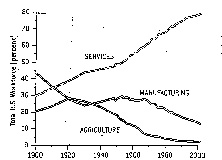 |
|
Figure 3. Deindustrialization: Changes in total U.S. workforce in 20th century (in %)
|
event greater than the Neolithic revolution, and comparable to the arrival of Homo habilis himself 1.6 million years ago. But the transition from a biological pattern of Darwinian evolution to social, information moderated explosive growth took a million years to develop. Now we have a mere 100 years to go through the last stage of this revolutionary transformation when the global population will level off.
The developed countries are already at this final stage and in recent developments one can discern the features of a future world with a stabilized population. In this world it
seems that numerical growth, primarily expressed by population growth will no longer dominate. The connection between population growth and the population will cease to express development. In this case there are two alternatives: one is stagnation of development in a world of zero growth. The other is to find a new dimension for development, and, as the quantitative growth of the past is gone, there is a possibility for qualitative growth and development. At present in developed countries there is a significant shift of the workforce from the production sector to services: health, education, science, leisure. These new processes of development are accompanied by an internationalization of finance and technology. The rapid transfer of information has become the principle feature of globalization and now the Internet is dominating the world as one of the main instruments of change.
On the other hand, one has to keep in mind that the process of globalization began long ago. For example science, fundamental science, right from its beginning was a global enterprise. Before that the main religions, known as world religions, were long ago global, just as languages, were by their common roots a global phenomenon. So culture and knowledge were, within the capacity of past civilizations, practiced globally to an extent we usually do not recognize, being overwhelmed by recent developments. All this supports the principle idea of the informational nature of the universal global interaction and provides the context for assessing the future. This future may well be an information dominated society, rather than the information moderated one of the past. Can this lead to a fundamental transition like the development of a new world awareness, a greater global consciousness realized by a communication systems such as the Internet? Could it be conjectured that such a system would evolve and finally self-organize itself into a qualitatively new entity?
These trends are discussed in detail in «Caring for the future. Making the next decades provide a life worth living». The report, published in 1996, was written by «The independent commission on population and quality of life», chaired by
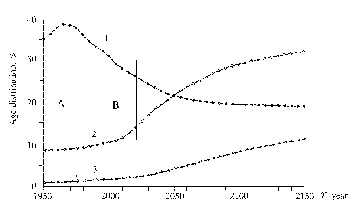 |
| Figure 4. Change in age distribution for the global population 1950 — 2150 1 — age group less than 14 years, 2 — age group older than 65 years, 3 — age group older than 80 years. A — age distribution in developing countries and B — age distribution in developed countries in 2000 |
Maria De Lourdes Pintasilgo, the former Prime Minister of Portugal. This report is in line with the Brandt report «North -South: a program for survival» (1979), the first on
